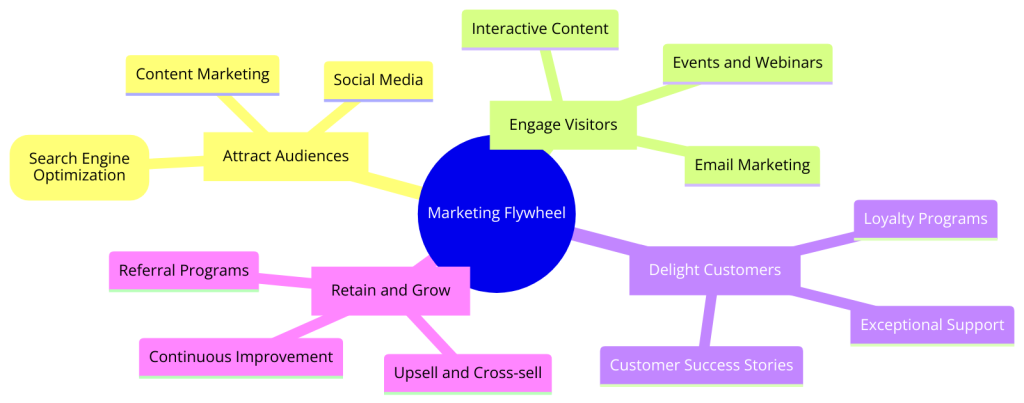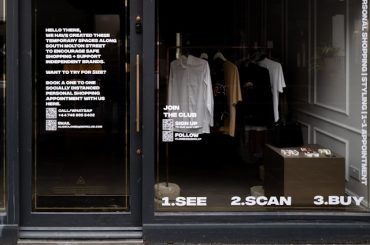The marketing flywheel is a concept that represents a shift from the traditional marketing funnel. The traditional funnel views the customer journey as a linear process starting with awareness and ending with a purchase, often neglecting the post-purchase experience. In contrast, the flywheel model emphasizes the momentum of engaging, delighting, and attracting customers in a continuous cycle that fosters growth.
Here’s a breakdown of the flywheel’s components:
- Engage: This phase involves interactions with potential and existing customers through various touchpoints to build relationships and address their needs or questions. Effective engagement strategies ensure that every interaction adds value and fosters trust.
- Delight: This phase focuses on exceeding customer expectations to create positive experiences that increase customer satisfaction and loyalty. Delighting customers can involve providing exceptional service, personalized experiences, and quality products that go beyond what they anticipated.
- Attract: Satisfied customers become advocates for the brand, sharing their positive experiences with others and attracting new prospects. This powerful word-of-mouth marketing helps bring new customers into the engagement phase, creating a self-sustaining cycle.
The flywheel is powered by the momentum generated from each happy customer. This leads to more referrals and repeat business, thereby reducing the cost of customer acquisition and driving growth. Unlike the funnel, which often ends with the sale, the flywheel is continuous, emphasizing the importance of post-purchase experiences in driving referrals and repeat sales.
The marketing flywheel model aligns well with inbound marketing strategies and customer-centric business approaches, focusing on providing value at every stage of the customer journey and leveraging satisfied customers to attract new ones.

Examples of Marketing Flywheel
- E-commerce Retailer: Amazon
- Engage: Amazon engages customers with personalized recommendations based on their browsing and purchase history and offers a seamless shopping experience.
- Delight: Prime members enjoy benefits like free two-day shipping, which often exceeds expectations, easy returns, and customer service.
- Attract: User reviews and ratings help attract new customers, while features like “Customers who bought this item also bought” facilitate word-of-mouth marketing.
- B2B Software Company: HubSpot
- Engage: HubSpot offers valuable content through its blogs, webinars, and inbound marketing courses, which are tailored to different stages of the customer journey.
- Delight: They provide exceptional onboarding and customer support, with dedicated account managers and a vast knowledge base.
- Attract: HubSpot encourages users to become brand advocates through their HubSpot Academy, user groups, and customer stories featured on their platform.
- Local Restaurant: Shake Shack
- Engage: Shake Shack interacts with its community on social media by sharing mouth-watering images and responding to customer feedback.
- Delight: Known for high-quality ingredients and excellent customer service, they often include surprise treats for regulars or during special promotions.
- Attract: Customers are encouraged to share their meals on social media, leading to organic growth through user-generated content and word-of-mouth.
- Fitness Studio: OrangeTheory Fitness
- Engage: OrangeTheory uses a tech-driven approach to keep members engaged with their fitness goals, offering a mobile app for tracking workouts and booking classes.
- Delight: They provide a personalized fitness experience with heart rate-based interval training and regular fitness assessments to show progress.
- Attract: Success stories and transformations are shared on social media, and they offer a “bring a friend” option to classes, helping to attract new members through existing ones.
These companies successfully apply the marketing flywheel concept by focusing on engaging, delighting, and attracting customers in a continuous, self-sustaining cycle that drives growth.
How do you design your organization’s marketing flywheel?
Designing a marketing flywheel for your organization involves creating a model prioritizing customer engagement, satisfaction, and advocacy, fostering a self-sustaining momentum that drives growth. Here’s a step-by-step guide to help you design your organization’s marketing flywheel:
- Understand Your Customer Journey
- Map It Out: Detail every stage of your customer journey, from the first interaction to post-purchase and beyond. Identify critical touchpoints where customers engage with your brand.
- Customer Feedback: Incorporate insights from customer feedback to understand their needs, pain points, and moments of delight.
- Segment the Flywheel into Key Phases: Break down the flywheel into the core phases of Engage, Delight, and Attract:
- Engage: Determine how you can meaningfully interact with customers at each touchpoint. This might include personalized communication, educational content, or responsive customer support.
- Delight: Identify opportunities to exceed customer expectations. This could involve product quality, customer service excellence, or unexpected perks and benefits.
- Attract: Consider how delighted customers can help you attract new ones. This might involve referral programs, sharing customer success stories, or leveraging positive reviews and testimonials.
- Align Your Team and Resources:
- Ensure that every department understands its role in the flywheel, from marketing and sales to customer service and product development.
- Allocate resources to enhance each phase of the flywheel, focusing on initiatives that contribute to customer satisfaction and advocacy.
- Implement Tools and Technologies
- Utilize CRM systems, marketing automation tools, and customer feedback platforms to streamline processes and gather insights.
- Leverage data analytics to track customer behavior, preferences, and feedback, enabling continuous optimization of the flywheel.
- Foster a Customer-Centric Culture
- Encourage a culture that puts customer satisfaction at the forefront of every decision and action.
- Recognize and reward employees who contribute to customer delight and advocacy.
- Continuously Monitor, Measure, and Optimize
- Establish KPIs for each phase of the flywheel, such as customer engagement rates, satisfaction scores, and referral numbers.
- Regularly review performance against these KPIs and adjust strategies to maintain momentum and drive growth.
- Leverage Customer Advocacy
- Encourage satisfied customers to share their experiences through case studies, testimonials, social media, or word-of-mouth.
- Consider implementing a formal referral program to incentivize and facilitate this process.
- Iterate and Innovate
- Stay adaptable and open to revising your flywheel strategy based on evolving customer needs, market trends, and technological advancements.
- Encourage innovation and experimentation within your team to find new ways to engage, delight, and attract customers.
Designing your marketing flywheel is an ongoing process that requires a deep understanding of your customers, a commitment to delivering exceptional value, and a strategic approach to leveraging customer satisfaction for growth. By focusing on creating a positive and self-reinforcing cycle, you can build a strong foundation for sustainable development and customer loyalty.
Types of Marketing Flywheel
The concept of a marketing flywheel is adaptable and can be tailored to fit different organizations’ unique needs and strategies. While the core idea remains focused on creating a self-sustaining cycle of engaging, delighting, and attracting customers, there can be variations in how the flywheel is conceptualized and implemented. Here are some types of marketing flywheels based on different focuses and strategies:
- Content-Driven Flywheel
- Focuses on leveraging high-quality, valuable content to engage customers at every stage.
- Content is the primary driver for attracting new prospects, engaging with them through educational and informative resources, and delighting them with insights and solutions that exceed their expectations.
- This approach is efficient for businesses that rely heavily on inbound marketing and thought leadership.
- Community-Focused Flywheel
- Centers around building and nurturing a community of users, customers, or advocates who are passionate about the brand or product.
- The community itself helps to engage new members, provide support, and share experiences, which in turn attracts more members.
- This is common in industries such as tech and lifestyle brands, where brand loyalty and user experience are paramount.
- Service-Centric Flywheel
- Prioritizes exceptional customer service and support to engage and delight customers.
- The emphasis is on solving problems quickly, providing personalized support, and going above and beyond to ensure customer satisfaction.
- This flywheel type is particularly relevant for service-based industries or companies with complex products requiring ongoing support.
- Product-Led Flywheel
- Relies on the product itself to drive engagement, delight, and attraction.
- Strategies might include free trials, freemium models, or user-friendly features encouraging sharing and referrals.
- This is effective for software and technology companies where the product offers clear, tangible value that users are keen to share.
- Experience-Based Flywheel
- Focuses on creating unique, memorable customer experiences that engage and delight.
- These experiences encourage customers to share their stories and bring new prospects into the flywheel.
- Suitable for businesses in hospitality, entertainment, and retail, where the customer experience is a key differentiator.
- Sustainability-Driven Flywheel
- Aligns the company’s sustainability efforts and values with customer engagement and advocacy.
- Customers engaged and delighted by the company’s commitment to sustainability become advocates, attracting like-minded individuals.
- This is ideal for organizations focused on environmental and social responsibility, where their mission and impact can drive customer loyalty and advocacy.
Each of these flywheel types emphasizes different aspects of the customer journey and leverages the organization’s unique strengths. The right type for your organization depends on your business model, industry, customer base, and strategic priorities. Adapting the flywheel concept to align with your core competencies and customer expectations can create a robust growth and retention mechanism.









